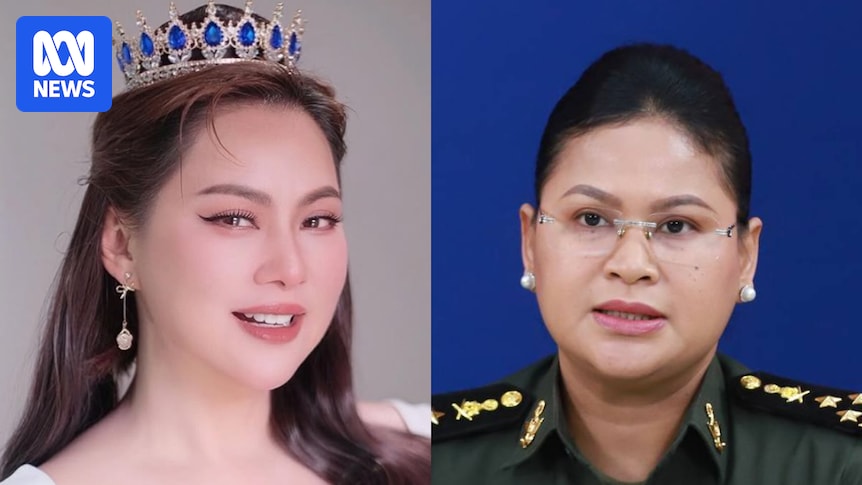
What began as a deadly clash over the contested border between Thailand and Cambodia has devolved into a fierce online battle of narratives. A ceasefire in July paused five days of fighting, during which at least 43 people were killed and more than 300,000 displaced. Yet, the conflict has now shifted to the digital realm, where nationalist myths are being revamped, a beauty queen has been appointed to counter a female general, and outdated footage is being used to make accusations of war crimes.
Despite the truce, tensions remain high along the border, with hundreds of thousands still displaced. The announcement comes as both nations engage in a war of words, leveraging digital platforms to sway public opinion and international perception.
From Pageantry to Press Briefings
According to Sebastian Strangio, South-East Asia editor of The Diplomat, Cambodia’s tone has shifted since the outbreak of the border clash. Initially, the rhetoric was dominated by scaremongering about territorial loss. However, Cambodia has since repositioned itself as the victim in this ongoing saga.
Strangio, who reported on the 2008 border conflict between Thailand and Cambodia, noted that Phnom Penh holds a strategic advantage in reframing the narrative. “The Cambodian side has had a high degree of message discipline … it controls most of the press,” he told the ABC. Daily briefings by Ministry of Defence spokeswoman Lieutenant General Maly Socheata have been used to “lob accusations at Thailand and to respond to things that Thailand has said or done,” he added.
Meanwhile, Thailand’s messaging has been more chaotic, reflecting the country’s fractured domestic politics. Strangio, who has authored several books on Cambodia and South-East Asia, observed, “Both sides claim to be innocent and their respective messaging is acrimonious and overblown, with no real common ground between the two sides and social media users.”
Thailand’s Prime Minister Paetongtarn Shinawatra was recently suspended by the country’s Constitutional Court following a leaked phone conversation with former Cambodian prime minister, Hun Sen.
This incident marked a souring of the previously amicable relationship between the two countries’ leading dynasties. “Obviously there is a big divide between [Thailand’s] civilian government and the military commanders, [who are] often making their own statements to the press,” Strangio noted.
A Beauty Queen in the Line of Fire
Cambodia’s communication strategy has been so successful that Bangkok recently named actress and former Miss Thailand Panadda Wongphudee as its official defense spokeswoman. “Let me make this straightforward, this appointment is to counter Lieutenant General Maly,” Deputy Defence Minister Nattaphon Narkphanit was quoted by the Bangkok Post as saying at a press conference. “At least I am confident that we hold one advantage over Cambodia: she is more beautiful.”
Piyarat Panlee, from Thailand’s Kasetsart University, expressed concern over this move, stating it had fueled a “meme-driven rivalry” on social media. Using a beauty queen as a celebrity spokeswoman risked putting spectacle over substance, Dr. Panlee warned. “In moments of cross-border tension, the most effective spokesperson is one who calms the waters rather than stirs them,” she said.
False Claims Fueling Tensions
One of the most viral falsehoods of the conflict originated from Lieutenant General Socheata, who claimed Thai fighter jets had dropped poison gas shells. The Royal Thai Armed Forces dismissed the allegation as “completely unfounded,” but the message continued to be spread by Cambodian media.
It then made its way into social posts, which shared photographs of an aircraft spraying a pink substance over forested hills. The wife of Cambodian Prime Minister Hun Manet also shared the misleading image. The claim was later debunked by news agency AFP’s Fact Check unit, which found the image was taken by Reuters during US wildfires in January.
“It’s frankly an insane claim to make without any evidence,” Strangio said.
Another unsubstantiated report accused Thai forces of plotting to assassinate Mr. Manet using a drone. Fact-checkers have also flagged Thai-language misinformation circulating, including a video that alleged Thailand had been building a wall on the frontier with Cambodia. These digital manipulations, according to AFP and other monitors, have stoked tensions and complicated independent reporting.
Nationalism Unifies Opponents
The border clash and subsequent disinformation campaigns have forged rare unity among the often-outspoken critics of the ruling Cambodian People’s Party (CPP). Cambodian diaspora communities around the world — including in Melbourne — have been staging protests. “It’s been quite remarkable,” Strangio said. “Everybody seems to be echoing the government’s talking points, including opposition figures.”
Within Thailand, public displays of the flag have multiplied since the conflict began. Thai flags have also appeared in New York’s Times Square in an effort to sway international communities. Both sides have tapped historic grievances, with Thai narratives focusing on “lost territories” while the Cambodian side has played into existential fears of being conquered by neighbors.
“These are now being translated to the digital sphere … taking on new forms,” Strangio said. “But they’re very old narratives.”
As the digital skirmishes continue, the international community watches closely, aware that the battle for truth in the digital age can have profound real-world consequences. The situation remains precarious, with both nations seemingly entrenched in their positions, leaving little room for diplomatic resolution. The world waits to see if cooler heads will prevail or if the digital war will escalate further.





